2021 Toyota 4Runner Review: Equipped for Adventure, Less for Leisure
Few SUVs can match the 4Runner off-road, but it is not an easy daily driver.
Capital One
Originally published on July 29, 2021
Article QuickTakes:
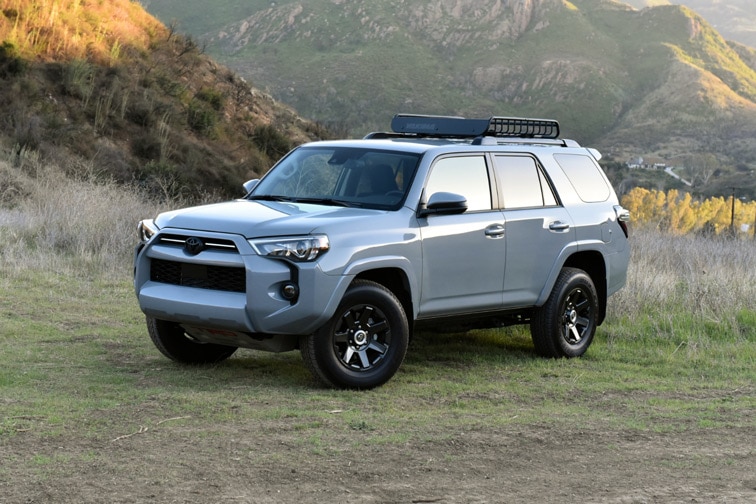 Christian Wardlaw
Christian Wardlaw
When only a traditional off-road-ready midsize SUV will do, the pickings can be slim. You can wait in line for a new version of the segment’s other two competitors or drive home in a Toyota 4Runner. Nearly every other SUV in the segment is a crossover, designed for the comfortable exploration of paved roads instead of unpaved, off-the-grid adventures.
As rugged and capable as the original 4Runner was in 1984, the 2021 Toyota 4Runner carries five people (or seven with the third-row seat). It is legendary for going places and doing things most other SUVs can’t. It also survived decades of vehicular abuse without much complaint. This reputation for unrelenting durability, in combination with its go-anywhere capability and do-anything image, undoubtedly helps to make the 4Runner one of the best-selling vehicles in America, despite its lack of refinement and seemingly unquenchable thirst for fuel.
Toyota sells the 2021 4Runner in SR5, TRD Off-Road, Limited, and TRD Pro trim levels. An optional Premium designation for SR5 and TRD Off-Road versions indicates a higher level of standard equipment. Three special edition 4Runners are also available: Trail, Venture, and Nightshade. Toyota 4Runner prices range from the upper $30,000s to the lower $50,000s.
For 2021, the 4Runner gains standard LED headlights and a new SR5-based Trail Special Edition variant. The top-of-the-line TRD Pro also gets new flow-form alloy wheels, a retuned suspension, and a Lunar Rock paint color.
For this review, Toyota provided a Trail Special Edition with optional four-wheel drive, a TRD skid plate, a premium infotainment system, and a cargo cover. The test vehicle cost nearly $44,000 including the destination charge.
 Christian Wardlaw
Christian Wardlaw
CLASSIC 4RUNNER STYLING MEETS REFRESHINGLY SIMPLE INTERIOR DESIGN
Looking ready for adventure, the 4Runner Trail Edition has trendy, dark gray TRD Off-Road aluminum wheels, black exterior badges, and a purposeful cargo basket mounted to the roof rack. The test vehicle’s flat cement gray paint added to its distinctive appearance.
Interior differences that set the SR5-based Trail Edition apart include black cloth seats with tan stitching, all-weather floor liners, a standard sliding cargo deck, and a custom-made, 40-quart cooler. Toyota says it will build only 4,000 models of the Trail Edition for the 2021 model year.
Constructed primarily of durable and solidly affixed plastic that is easy to clean up, the 4Runner Trail Edition’s interior is basic. However, the simplicity of the buttons, knobs, and even their markings is refreshingly analog in an increasingly digital world. With the Trail Edition, you even use a traditional key in a cylinder lock on the steering column instead of an engine start button.
Getting in and out may not be easy for some people, but comfort is excellent, once you’ve clambered aboard over the SUV’s high sills. The 4Runner’s roofline is also rather low, so headroom could be an issue for some. I found the 4Runner to be quite comfortable, especially in the second-row seat. There is plenty of rear legroom, and Toyota positions both the bottom cushion and the backrest to provide proper support. Plus, they recline up to 16 degrees for even more relaxed riding.
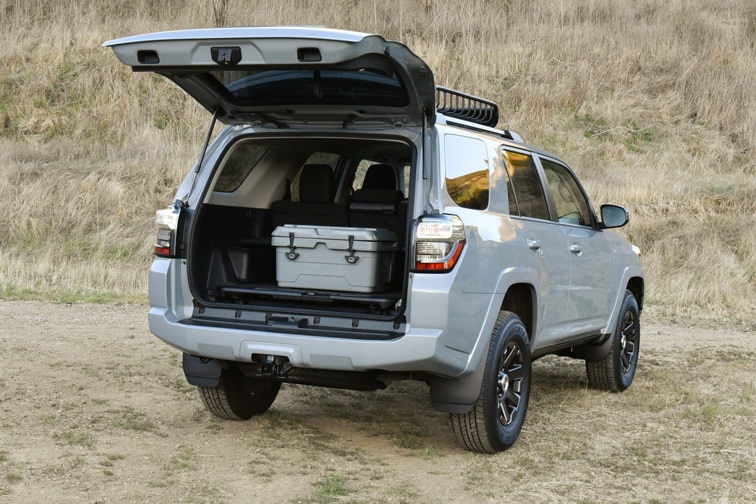 Christian Wardlaw
Christian Wardlaw
The test vehicle did not have the optional third-row seat because Toyota makes the pull-out cargo deck standard for the Trail Edition. The cargo deck slides in and out of the SUV to make loading heavy items easier, and it supports 440 lbs. Cargo space measures 47.2 cu. ft. behind the rear seat and 89.7 cu. ft. maximum. With the cargo deck, the numbers shrink a bit to 46.3 and 88.8, respectively.
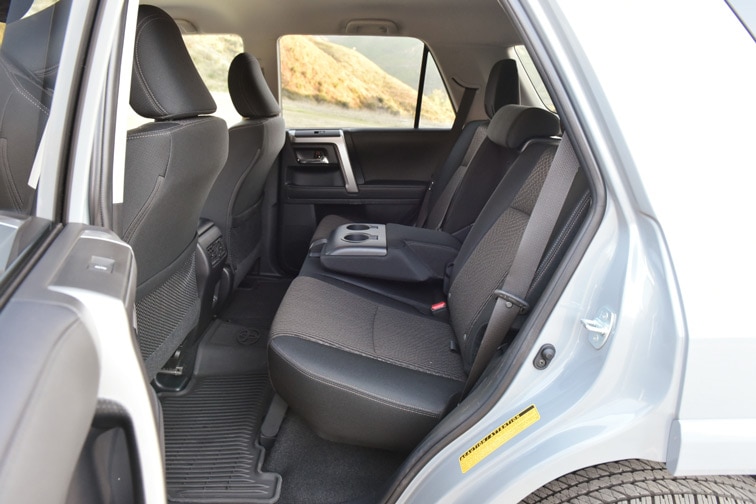 Christian Wardlaw
Christian Wardlaw
One great thing about the 4Runner is the rear window powers down into the liftgate. Open it along with the SUV’s side windows and the available power sunroof, and the 4Runner offers a similar, open-air driving feel to a Jeep Wrangler without as much hassle or exposure to the sun’s harmful UV rays.
 Christian Wardlaw
Christian Wardlaw
IMPRESSIVE INFOTAINMENT, UNIMPRESSIVE SAFETY
For a relatively simple and old-school SUV, the software powering the 4Runner’s infotainment system is surprisingly sophisticated. The 8-inch touchscreen is rather small and dated in appearance, but it comes with standard smartphone mirroring, Amazon Alexa integration, satellite radio, and connected services with free trial periods to Safety Connect and Wi-Fi Connect plans.
As an upgrade, a cloud-connected navigation system with natural voice recognition is available, and it quickly and faithfully interprets spoken commands. Expanded access to connected and personal concierge services are also included with navigation-equipped infotainment systems. Separately, Toyota offers a 15-speaker premium sound system with selected trim levels.
Toyota Safety Sense-P is standard for every 2021 4Runner, a suite of advanced driving assistance systems with adaptive cruise control, forward-collision warning and pedestrian detection, automatic emergency braking, lane-departure warning, and automatic high-beam headlights. A blind-spot warning system is not available for this SUV, and the lane-departure warning system’s beeping quickly becomes a source of irritation, prompting this driver to turn it off.
When it comes to crash-test ratings, the 4Runner’s engineering age shows. For example, the National Highway Traffic Safety Administration (NHTSA) gives the 4Runner a 3-star rating out of a possible 5 stars for front-passenger protection in a frontal-impact collision. The rollover resistance rating also measures 3 stars.
The Insurance Institute for Highway Safety (IIHS) gives the 4Runner top ratings for most evaluations, but in the driver’s side, small-overlap, frontal-impact test the SUV earns no better than a “Marginal” rating. The IIHS hasn’t tested the SUV’s performance in this same assessment on the front passenger’s side.
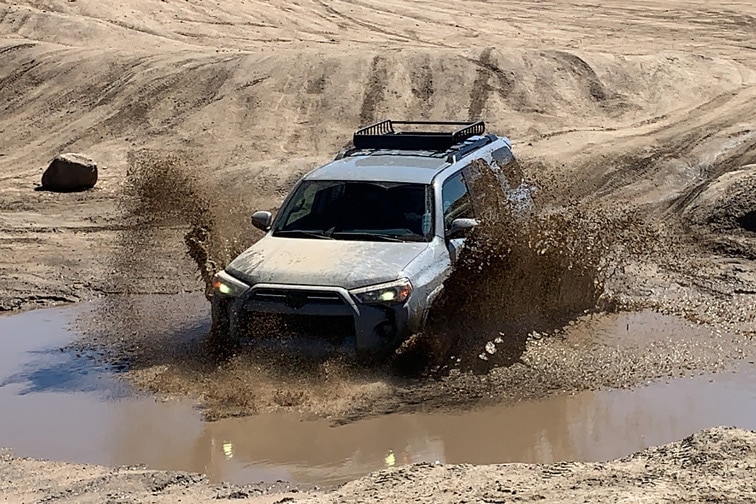 Christian Wardlaw
Christian Wardlaw
OUTDATED DAILY DRIVER, WONDERFUL WEEKEND WARRIOR
Charged with moving a minimum of 4,400 lbs of SUV (SR5 2WD), the 4Runner’s 4.0L V6 might be reliable but it’s not very strong or economical.
It makes a modest 270 horsepower at 5,600 rpm and 278 lb.-ft of torque at 4,400 rpm. And it uses a proven, but increasingly archaic, 5-speed automatic transmission to drive the rear or all four wheels. Part-time 4WD is optional for most models, and standard on the TRD Pro. The Limited and Nightshade Special Edition use a full-time 4WD system.
In spite of its rugged body-on-frame construction, maximum towing capacity measures just 5,000 lbs. Because the 4Runner is heavy and shaped like a brick, it gets middling fuel economy. The Environmental Protection Agency (EPA) rates it at 17 mpg in combined driving, and our test vehicle returned an even 16 mpg on the evaluation route.
Driving a 4Runner on a daily basis is a novelty at first, but it doesn’t take one long before tiring of the slow and heavy steering, grabby brakes, difficult ride, and the laborious drivetrain that forces frequent stops at the gas station.
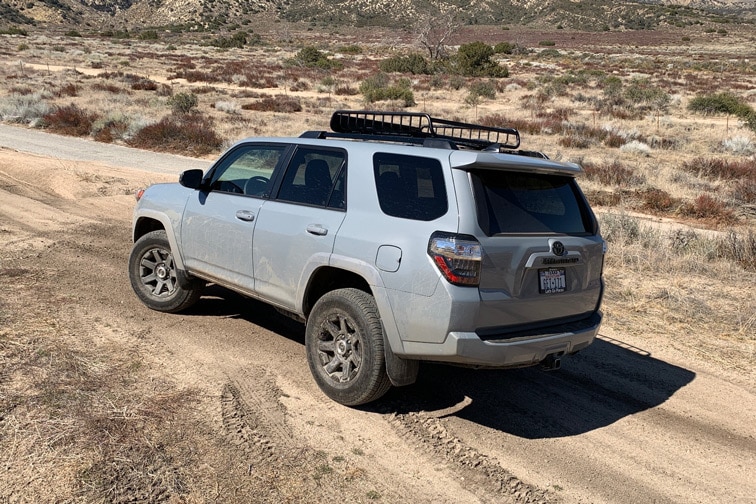 Christian Wardlaw
Christian Wardlaw
What the 4Runner gives up in terms of power, efficiency, and sophistication during the daily drive, it makes up for with off-roading hardware and capability. While the Trail Special Edition test vehicle lacked the locking and limited-slip center differential, Crawl Control off-road cruise control system, and Multi-Terrain Select off-road driving modes that you can get on other versions of the 4Runner, it nevertheless shrugged off the terrain of a Southern California off-highway vehicle park.
Granted, aside from sampling some of the more difficult off-road testing challenges designed and maintained by park rangers (one is known as the “frame twister”), we kept to trails best matched to our skills and the Trail Special Edition’s basic 4WD systems. This prudent approach demonstrated that a 4Runner on the more affordable end of the scale is more than capable. And we also discovered that the cement paint color does a good job of hiding the dirt of the Tehachapi Mountains.
 Christian Wardlaw
Christian Wardlaw
THE DEFINITION OF AN AUTOMOTIVE DICHOTOMY
The 2021 Toyota 4Runner is a love-hate type of vehicle. It's fuel inefficient, not terribly fun to drive on pavement and, if safety ratings are anything to go by, potentially less safe in a collision. The 4Runner’s single-purpose intent and advanced age of its design and engineering are both plainly evident and a detriment to daily driving enjoyment.
Yet, you can’t help but love this old-fashioned SUV. It has panache, something that’s missing from the majority of crossover SUVs that are better at pounding pavement than they are dirt. The 4Runner is seemingly unstoppable, both off-road and in terms of its proven reputation for reliability. It eliminates some of the worry about whether you’ll make it into the wilderness but not back out again.
And when it comes to five-passenger comfort combined with roomy cargo accommodations and outright attitude, few other midsize SUVs come close to delivering like the Toyota 4Runner does. So if you’re a true creature of the wild, the 2021 Toyota 4Runner may prove to be a kindred spirit for life’s most challenging adventures. If you’re simply wild at heart, the 17 mpg fuel rating may rudely dampen your monthly budget, and your wanderlust.



